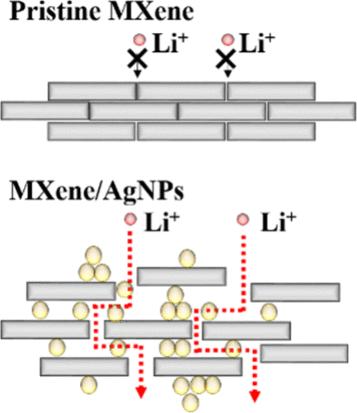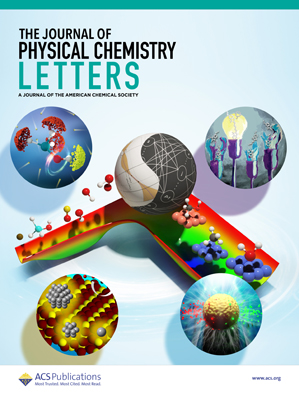Tuning MXene Pathways via Silver Nanoparticle Size Variations for Anode-Free Battery Applications
IF 4.8
2区 化学
Q2 CHEMISTRY, PHYSICAL
引用次数: 0
Abstract
MXenes, a class of two-dimensional titanium carbide materials, have emerged as promising materials for film-based applications due to their exceptional properties. However, their densely layered structures hinder ion diffusion, metal-ion mobility, and nanoscale particle transfer, limiting their potential in energy-related applications. Expanding and controlling interlayer spacing is essential for overcoming these limitations and optimizing MXene performance. In this study, silver nanoparticles (AgNPs) measuring 20 and 55 nm in size were incorporated into dense MXene structures to control and expand their pathways. X-ray diffraction confirmed the lamellar structure of pristine MXene, and detailed analyses using electron microscopy and small-angle neutron scattering demonstrated that the size and concentration of AgNPs directly influenced pathway expansion. The interlayer spacing increased significantly, with widths growing from 2.4 nm to ∼25 nm as the AgNP parameters varied. Electrochemical impedance spectroscopy results revealed that the densely packed structure of pristine MXene was unsuitable for use as an anode-current collector coating in batteries. In contrast, the MXene/AgNP composite demonstrated effective functionality due to the expanded pathways, which improved ion transfer and conductivity. These findings underscore the importance of pathway engineering and the use of additive insertion methods in advancing MXene-based materials for energy storage and other functional applications.

求助全文
约1分钟内获得全文
求助全文
来源期刊

The Journal of Physical Chemistry Letters
CHEMISTRY, PHYSICAL-NANOSCIENCE & NANOTECHNOLOGY
CiteScore
9.60
自引率
7.00%
发文量
1519
审稿时长
1.6 months
期刊介绍:
The Journal of Physical Chemistry (JPC) Letters is devoted to reporting new and original experimental and theoretical basic research of interest to physical chemists, biophysical chemists, chemical physicists, physicists, material scientists, and engineers. An important criterion for acceptance is that the paper reports a significant scientific advance and/or physical insight such that rapid publication is essential. Two issues of JPC Letters are published each month.
 求助内容:
求助内容: 应助结果提醒方式:
应助结果提醒方式:


